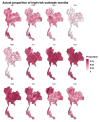Seasonal and Meteorological Drivers of Hand, Foot, and Mouth Disease Outbreaks Using Data-Driven Machine Learning Models
- PMID: 39998051
- PMCID: PMC11860531
- DOI: 10.3390/tropicalmed10020048
Seasonal and Meteorological Drivers of Hand, Foot, and Mouth Disease Outbreaks Using Data-Driven Machine Learning Models
Abstract
Hand, Foot, and Mouth Disease (HFMD) predominantly affects children under the age of five and remains a significant public health concern in the Asia-Pacific region. HFMD outbreaks are closely linked to seasonal changes and meteorological factors, particularly in tropical and subtropical areas. In Thailand, a total of 657,570 HFMD cases were reported between 2011 and 2022 (12 years). This study aimed to identify the high- and low-risk HFMD outbreak areas using machine learning models: Logistic Regression (LR), Support Vector Machine (SVM), Decision Tree (DT), Random Forests (RF), Gradient Boosting Machine (GBM), and Extreme Gradient Boosting (XGBoost). Our findings showed that the XGBoost model outperformed the other models in predicting unseen data and defining the best model. The best model can be used to detect high-risk outbreak areas and to explore the relationship between meteorological factors and HFMD outbreaks. The results highlighted the seasonal distribution of high-risk HFMD outbreak months across different provinces in Thailand, with average maximum temperature, average rainfall, and average vapor pressure identified as the most influential factors. Furthermore, the best model was used to analyze HFMD outbreaks during the COVID-19 pandemic, showing a notable reduction in high-risk outbreak months and areas, likely due to the control measures implemented during this period. Overall, our model shows great potential as a tool for warnings, providing useful insights to help public health officials reduce the impact of HFMD outbreaks.
Keywords: and mouth disease; foot; hand; machine learning; meteorological factors; outbreak detection.
Conflict of interest statement
The authors declare no conflicts of interest.
Figures







Similar articles
-
Analysis and prediction of hand, foot and mouth disease incidence in China using Random Forest and XGBoost.PLoS One. 2021 Dec 22;16(12):e0261629. doi: 10.1371/journal.pone.0261629. eCollection 2021. PLoS One. 2021. PMID: 34936688 Free PMC article.
-
Different effects of meteorological factors on hand, foot and mouth disease in various climates: a spatial panel data model analysis.BMC Infect Dis. 2016 May 26;16:233. doi: 10.1186/s12879-016-1560-9. BMC Infect Dis. 2016. PMID: 27230283 Free PMC article.
-
Exploring the influence of COVID-19 on the spread of hand, foot, and mouth disease with an automatic machine learning prediction model.Environ Sci Pollut Res Int. 2023 Feb;30(8):20369-20385. doi: 10.1007/s11356-022-23643-z. Epub 2022 Oct 18. Environ Sci Pollut Res Int. 2023. PMID: 36255582 Free PMC article.
-
Association of Short-Term Exposure to Meteorological Factors and Risk of Hand, Foot, and Mouth Disease: A Systematic Review and Meta-Analysis.Int J Environ Res Public Health. 2020 Oct 30;17(21):8017. doi: 10.3390/ijerph17218017. Int J Environ Res Public Health. 2020. PMID: 33143315 Free PMC article.
-
Temperature and humidity affect the incidence of hand, foot, and mouth disease: a systematic review of the literature - a report from the International Society of Dermatology Climate Change Committee.Int J Dermatol. 2019 Apr;58(4):388-399. doi: 10.1111/ijd.14188. Epub 2018 Sep 5. Int J Dermatol. 2019. PMID: 30187452
Cited by
-
Predicting and explaining high dead-on-arrival outcomes in meat-type ducks using deep learning: A path to improved welfare management.Poult Sci. 2025 Sep;104(9):105439. doi: 10.1016/j.psj.2025.105439. Epub 2025 Jun 13. Poult Sci. 2025. PMID: 40541105 Free PMC article.
References
-
- Min N., Ong Y.H.B., Han A.X., Ho S.X., Yen E.W.P., Ban K.H.K., Maurer-Stroh S., Chong C.Y., Chu J.J.H. An Epidemiological Surveillance of Hand Foot and Mouth Disease in Paediatric Patients and in Community: A Singapore Retrospective Cohort Study, 2013–2018. PLoS Negl. Trop. Dis. 2021;15:e0008885. doi: 10.1371/journal.pntd.0008885. - DOI - PMC - PubMed
LinkOut - more resources
Full Text Sources

